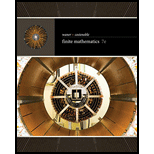
Study Techniques Your mathematics test is tomorrow and will cover the following topics: game theory, linear programming, and matrix algebra. You have decided to do an all-nighter and must determine how to allocate your 8 hours of study time among the three topics. If you were to spend the entire 8 hours on any one of these topics (thus using a pure strategy), you feel confident that you would earn a 90% score on that portion of the test but would not do so well on the other topics. You have come up with the following table, where the entries are your expected scores. (The fact that linear programming and matrix algebra are used in game theory is reflected in these numbers.)
Test
| Your Strategies | Game | Linear Programming | Matrix Algebra |
| Game Theory | 90 | 70 | 70 |
| Linear Programming | 40 | 90 | 40 |
| Matrix Algebra | 60 | 40 | 90 |
You have been told that the test will be weighted as follows: game theory: 25%, linear programming: 50%, and matrix algebra: 25%.
a. If you spend 25% of the night on game theory, 50% on linear programming, and 25% on matrix algebra, what score do you expect to get on the test?
b. Is it possible to improve on this by altering your study schedule? If so, what is the highest score you can expect on the test?
c. If your study schedule is according to part (a) and your teacher decides to forget her promises about how the test will be weighted and instead bases it all on a single topic, which topic would be worst for you, and what score could you expect on the test?
Trending nowThis is a popular solution!

Chapter 4 Solutions
Finite Mathematics
- In preparing for the upcoming holiday season, Fresh Toy Company (FTC) designed a new doll called The Dougie that teaches children how to dance. The fixed cost to produce the doll is $100,000. The variable cost, which includes material, labor, and shipping costs, is $31 per doll. During the holiday selling season, FTC will sell the dolls for $39 each. If FTC overproduces the dolls, the excess dolls will be sold in January through a distributor who has agreed to pay FTC $10 per doll. Demand for new toys during the holiday selling season is extremely uncertain. Forecasts are for expected sales of 60,000 dolls with a standard deviation of 15,000. The normal probability distribution is assumed to be a good description of the demand. FTC has tentatively decided to produce 60,000 units (the same as average demand), but it wants to conduct an analysis regarding this production quantity before finalizing the decision. (a) Determine the equation for computing FTC's profit for given values of the…arrow_forwardFor all integers a and b, (a + b)^4 ≡ a^4 + b^4 (mod 4).arrow_forwardFor all integers a and b, (a + b)4 = a4 + b4 (mod 4). write a counterexamplesarrow_forward
- For all integers a and b, (a + b)^2 ≡ a^2 + b^2 (mod 2).arrow_forwardFor all integers a and b, (a + b)^3 ≡ a^3 + b^3 (mod 3).arrow_forwardFind a plane containing the point (3, -3, 1) and the line of intersection of the planes 2x + 3y - 3z = 14 and -3x - y + z = −21. The equation of the plane is:arrow_forward
- Determine whether the lines L₁ : F(t) = (−2, 3, −1)t + (0,2,-3) and L2 : ƒ(s) = (2, −3, 1)s + (−10, 17, -8) intersect. If they do, find the point of intersection. ● They intersect at the point They are skew lines They are parallel or equalarrow_forwardAnswer number 15arrow_forwardWhy researchers are interested in describing measures of the center and measures of variation of a data set?arrow_forward
- Let Χ be a real-valued character (mod k). Let k S = Σnx(n). n=1 If (a, k) = 1, ax(a)S = S (mod k). (iii) Write k = 2ºq where q is odd. Show that there is an integer a with (a, k) = 1 such that a = 3 (mod 2ª) and a = 2 (mod q). Deduce that 12S = 0 (mod k).arrow_forwardSolve for 14arrow_forwardWHAT IS THE SOLUTION?arrow_forward
 Elementary Geometry for College StudentsGeometryISBN:9781285195698Author:Daniel C. Alexander, Geralyn M. KoeberleinPublisher:Cengage Learning
Elementary Geometry for College StudentsGeometryISBN:9781285195698Author:Daniel C. Alexander, Geralyn M. KoeberleinPublisher:Cengage Learning
